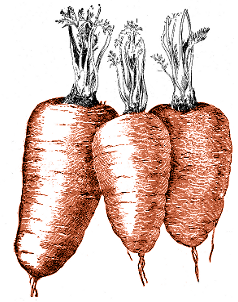Posts tagged ‘potato’
Posted in Garden Diary, Photobloggery, The Old Garden In Bristol on Saturday, December 1st 2012 (8.36 PM).
This week, it really feels as if the garden is properly getting itself going. More and more insects are out and about, and more things are starting to come alive. The lettuce and calendulas sown three weeks ago have just made their first appearance above ground, and the pea seedlings which have been growing on the kitchen windowsill are getting larger and larger, stretching their tendrils like the most grotesque of scarecrows. Today I started hardening them off ready for planting out; I probably should have done it earlier.
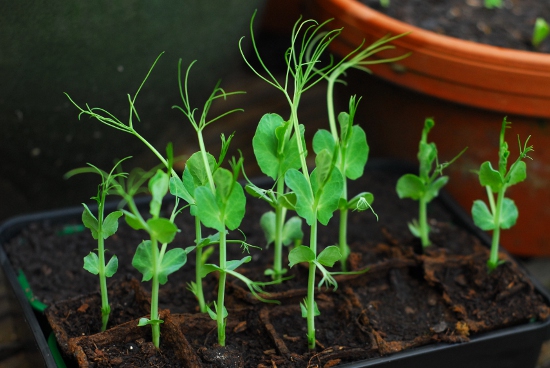
More peas will start germinating soon. The first batch of this year’s potato crop went into the ground today too – well, into their container. This year we picked Red Duke Of York, as something we are unlikely to see in the greengrocers, and I’ve tried to squeeze four tubers into the container rather than last year’s three. The second batch will be planted in about a month’s time.
To get the potatoes, we popped over to the Riverside in Southville. Naturally, we were rather tempted by their selection of herb plants. Possibly too tempted: intending go there purely to get potatoes, we also came home with a black peppermint, some sweet peas, and two fennel plants. The fennel is instead of the dill we grew last year; I will explain more about that later.
black peppermint, calendula, fennel, lettuce, marigold, mint, pea, peppermint, potato, spring, sweet pea
Posted in Garden Diary, Photobloggery, The Old Garden In Bristol on Sunday, July 22nd 2012 (7.20 PM).
The first batch of potatoes, Red Duke Of Yorks, is now up and out of the ground. By “ground” I mean “bin”, of course.
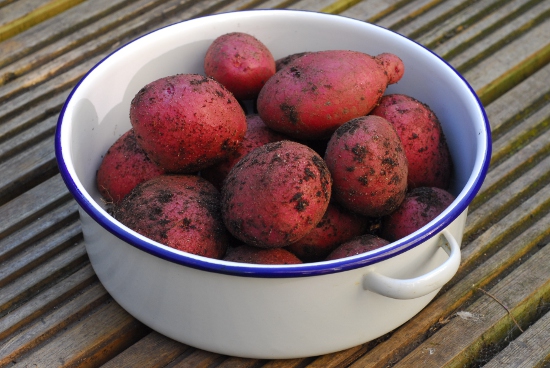
And when I say “first batch”, I mean “second batch”. The second batch of potatoes, the ones that were hugely leggy because their shoots were already six inches in length when I planted them, died off well before the plants from the first batch, one of which is still in full greenery. Presumably this is a result of the shoots being far too long; which, in turn, led to them having much more trouble with the bad weather.
harvest, potato
Posted in Garden Diary, Retrospective, The Old Garden In Bristol on Saturday, July 7th 2012 (2.50 PM).
A week ago, we passed the midpoint of the calendar year; a week or two before that, the midpoint of the solar year. A good place, I thought, to put together a little bit of a summary on how things are growing so far. With the weather, of course, it’s not going too well. There are bright spots, though. Here’s a summary, at least of the plants that are worth talking about.
- Potatoes: they’re not quite ready yet. Of the two batches of potatoes I planted, the first seem to be doing quite well. The second, though, are having problems. When I planted them, they were already far too leggy, and they stayed far too leggy as they grew. Because of that, they haven’t coped with the weather at all: they have flopped all over the place. For some reason, floppy potato plants are far more attractive to slugs and snails than tidy, well-behaved ones are.
- Green beans: the first batch were planted far too early, but happily sat in their pot for a month or two until the weather was warm enough. They’ve just reached the top of their poles, buds are starting to come, and the second batch I germinated are now ready to pot on.
- Runner beans: these went in a bit later than the green beans, and are already in full flower. They seem to be a little reluctant to set fruit, though; only one or two tiny embryo beans have been spotted so far. The standard advice for persuading beans to set seems to be “spray the flowers with water”, but given the weather I don’t really think that would help. Most of the salad leaves I planted around the base of the beans completely bolted before the weather turned wet, but some of the lettuce has been harvested and eaten.
- Garlic: also looking a bit windblown, and also not quite ready yet. They have, in the past couple of days, very quickly put forth a scape on each plant: the scapes are now safely in the fridge for eating.
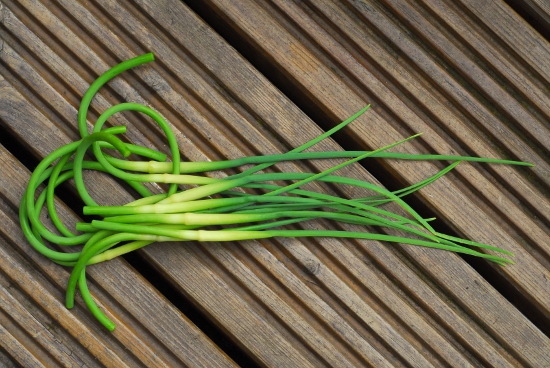
- Peas: if you ever hear anyone say to you “semi-leafless peas are self-supporting when sown in a block”, put your hands over your ears. And tape their mouth shut. And shoot them. This may be true in theory, but in reality I found that the growing peas could not cope at all with the weight of their pods. The first batch has already been harvested; and when I took them down, I could see just how twisted and serpentine the later batches have become. A final extra-big batch has been sown and planted on, spaced slightly further apart and with a lot more support provided by horizontal strings: I suspect the tight planting of the first couple of batches was the cause of the large number of pods with just two or three peas inside.
- Courgettes: the first of these were planted on about a month ago now, and seem to be doing fairly well. The first few flowers have bloomed: the problem is that with only a handful of plants, and the flowers only lasting a few days, it is difficult to get male and female flowers in bloom at the same time.
- Lemon balm: I picked these seeds up at the Bristol Seed Swap at the Cube Cinema back in February. Back in May, I put them in a pot, and waited for them to grow. Nothing happened, and I assumed something had gone wrong: all died, all rotted, all eaten by evil weevils. However, just this morning, I spotted one tiny seedling starting to emerge. Maybe it will turn out to be a lemon balm plant. So there’s a bright spot.
Writing out a list like this makes me aware of just how many different plants there are in the garden at the moment: I haven’t even had space to mention the mint; the basil mint; the peppermint; camomile; chervil; borage; French marigolds; English marigolds; cornflowers; thyme; lemon thyme; sage; rosemary; lavender; sweet peas; flat parsley; curly parsley; the fennel; or the chard. Probably best not to mention the chard at all, in fact, because I’m sure it’s a bad sign when your chard and your beans are the same height. Time to plant some more there, I think.
bean, chard, courgette, garlic, green bean, lemon balm, pea, potato, runner bean, summary, swiss chard
Posted in Garden Diary, The Old Garden In Bristol on Sunday, June 10th 2012 (10.52 PM).
We noticed last weekend that the first pods of peas looked ready for eating. You can’t make much of a meal from a couple of pods of peas, of course, so we ate the first one fresh off the plant, cracked open with my thumb and shared out in the garden.
The plants have all coped reasonably well with the past week’s bad weather. The potatoes, though, have been left rather rain-battered with a few stalks snapped off; and the garlic is looking a bit windblown. Hopefully none of this will affect what is under the ground.
garlic, pea, potato, weather
Posted in Garden Diary, Photobloggery, Practicalities, The Old Garden In Bristol on Monday, May 14th 2012 (10.31 PM).
Never trust anything you read, especially if it is on the back of a seed packet. “Self-supporting if sown in a block”, it says on the back of the packet of peas I’ve been sowing for the past couple of months. Self-supporting if sown in a block. Now, I admit, the pea stems aren’t exactly lying flat on the ground, but they have lurched rather drunkenly over to one side, the well-grown stems from the first batch completely swamping the later ones. I have, rather belatedly, added some string to prop everything up and get everything growing a bit more upright. I’m not too sure how these peas are doing: the first batch may have plenty of leaf and tendril, but there is no sign of any sort of flower yet.
Both batches of potatoes are well up now and have completed earthing up – the second batch with a few sprigs of leaves showing, the first batch with a good head of foliage. The leaves of this year’s variety are, initially, a beautiful deep maroon in colour.
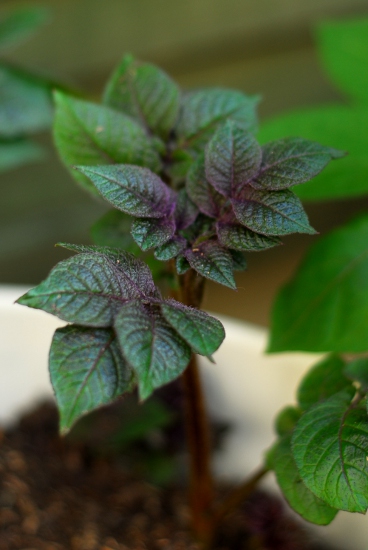
I was hoping that the plants would retain the colour as they grow. As the leaves get larger, however, they fall back to a more conventional deep green, with only the midrib and some of the larger veins keeping the red pigment. There is no sign yet, touch wood, of the leafhoppers which plagued our potatoes last year.
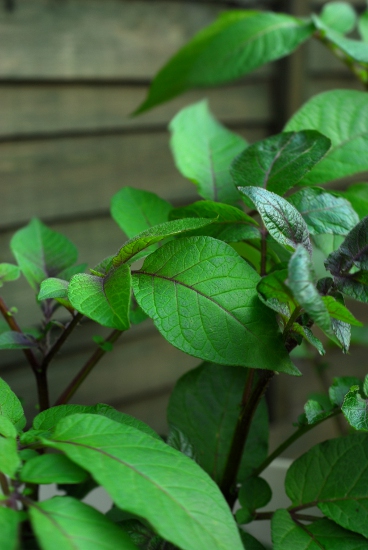
Two weeks ago, I sowed the main batch of courgette seeds, and was rather wary. We’ve not tried to grow them before, and I’ve heard stories of people having lots of trouble with them this year. However, in exactly 7 days every seed in the batch had germinated and was showing itself above the surface. I’ve killed off one as it was showing signs of rot, but the rest seem to be going well. They have started hardening up, and before they’re three weeks old should be ready for planting out.
One last thing for today: if you read Alys Fowler’s advice column in the Guardian Weekend magazine, you might have noticed last Saturday’s query about mossy containers. My mossy containers, that is: that was my letter! In particular, the container with our Swiss chard plants in, which developed a thick green carpet last autumn which didn’t seem to bother the plants at all. I shall stop worrying now that the moss might be bad for them.
courgette, pea, potato, swiss chard
Posted in Garden Diary, Practicalities, The Old Garden In Bristol on Wednesday, April 18th 2012 (10.20 PM).
After being lazy for far too long, this week I have finally managed to get our second batch of potatoes into the ground. Another potato bin, the same as the first, was acquired from a certain Swedish-Dutch furniture giant; its base was thoroughly perforated; and I delved into the cupboard under the stairs to find the bag of Red Duke Of York seed potatoes we bought from the Riverside over a month ago now. Unfortunately, I discovered a bit of a problem.
Some authorities on potatoes, you may already know, suggest chitting your tubers before planting. Leave them in a suitable spot, undisturbed, to get to work growing shoots, to give them a bit of a head start when they get in the ground. Other authorities say they’ve found chitting more trouble than it’s worth, because the chitted shoots are rather too prone to damage and can easily break off, leaving a potato with no more eyes and no more chance of growth. All of these authorities say that: if you do chit, plant the tubers when the shoots are about a couple of inches long.
Well, with our second batch of potatoes for this year we didn’t get any choice in the matter. Going under the stairs to find them, I discovered that they had managed to thoroughly chit themselves, all around each other and through the sides of the bag they were in, to a good six or seven inch length. Getting plantable potatoes out of the bag, without breaking the shoots off was an incredibly delicate job; and I hate to think how much I damaged them when backfilling their planting holes and firming them in. Still, most of my earthing up has already effectively been done, I suppose. It remains to be seen if any potatoes will result.
Nevertheless, the first batch of potatoes is doing well, with a good showing of richly-coloured dark maroon-green leaves coming up from at least two of the tubers. The coriander seeds I mentioned in the last post have germinated well, after about 10 days on the windowsill; and the runner beans I sowed at the same time are now all a good few inches in height. It will be tempting, if we get a warm Sunday in the next few weeks, to get my tripod out and try doing a time-lapse video of the runner bean vines coiling their way up their poles.
bean, chitting, coriander, planting, potato, runner bean, sowing
Posted in Experimentation, Garden Diary, Planning, The Old Garden In Bristol on Saturday, April 7th 2012 (9.44 PM).
The long Easter weekend: time to catch up on the planting schedule, and get some digging done. In the past couple of weeks, we have:
- Planted more peas.
- Planted green beans and runner beans, to germinate on the windowsill
- Planted some coriander to grow from seed
It does feel as if I should be doing an awful lot more, given the season and the warming of the weather. It doesn’t help that Symbolic Towers has, literally, nothing more than a single windowsill for plant germination, and despite last week’s warm spell the ground still isn’t warm enough for outdoor plants to be moving very quickly.
The potatoes are springing up, though, with lovely dark red foliage. Unfortunately only two of the tubers seem to have grown, so I slyly slipped another into the depths of the container at the start of this week. No sign of it coming up yet; but it means that the earthing-up has become rather uneven, the soil inside the container now having a mountainous slope to it.
The first of the seeds we saved last autumn have been planted. Of a batch of six green beans, only one came up: it has been planted outside, with poles to climb up, and is looking a little lonely. Hopefully the next batch of green beans – put under plastic to germinate this time – will have a greater success rate. At least the bamboo poles give the garden some height, something that has been missing since last year’s batch of beans was finally cut down last November. The second batch of peas has now been planted out too; the first are a tangled mass of interlocking tendrils quickly climbing up each other’s arms.
What will be coming next? Well, there are still more potatoes to plant. Moreover, with the drier weather I’ve been able to restart work on digging up the back bed. I think I mentioned that project back when this blog first started: basically, as the walled bed at the back of the garden was full of broken glass and bindweed roots, we decided to dig it all out completely and sift through all the earth; I didn’t fancy, some time in the future, to plunge my fingers into the ground without thinking and stab them on a pointy shard. It has taken a while, but the end of the digging-up project is starting to come into sight; and when it does, maybe next month, we will have an awful lot more growing space to play with. So much, in fact, I’m not entirely sure what we will do with it all. Maybe it’s time I started looking into perennial vegetables that don’t mind a slightly shady spot.
back bed, coriander, green bean, pea, potato, runner bean, sowing, sowing plan, spring
Posted in Retrospective, The Old Garden In Bristol on Saturday, October 1st 2011 (11.10 AM).
The list, in the previous post, of plants we’ve grown this year wasn’t really in any particular order; just off the top of my head as I cast my mind around the garden. Here, though, are some of the plants that we can say were a success.
Potatoes: probably our biggest success, grown in a dustbin with holes drilled in the bottom. We grew them in a mixture of soil and compost, at first, earthing up regularly with compost until it reached the top of the bin. I was expecting flowers and fruit, which we didn’t get; and we were rather worried about a leafhopper infestation which developed, damaging the leaves quite a bit. When the foliage died back, though, we upended the bin and found a healthy crop, about 600g per seed. Next year, we hope to have room for a couple more bins.
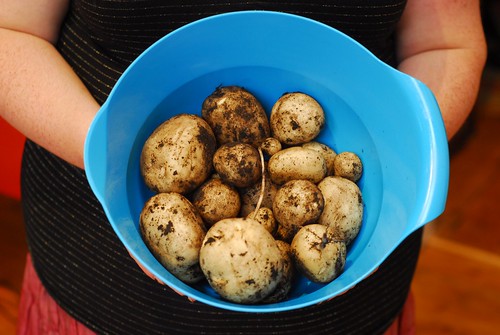
Peas: we bought small plants from the garden centre, planted them up in wine boxes, and put them on top of the garden wall, trained up the latticework. Again, each plant gave us a plentiful harvest; but we did have a bit of a mildew problem, probably caused by planting too many in each box.
French marigolds: we didn’t manage to eat any, but the plants themselves have gone happily on producing flowers all summer. They’re still in flower now, with more buds on the way.
Swiss chard: we planted this in a variety of containers, and tried harvesting and eating it at a variety of stages, from baby leaves to fully-grown leaves and stems. All of them worked pretty well: the baby leaves were ready fairly fast, and harvesting most of those left room for a few plants to grow into adulthood. Moreover, what we weren’t expecting was that we would be able to treat the adult plants in a cut-and-come-again fashion; we thought we’d harvested everything we could a few weeks back, but we now have healthy and harvestable leaves waiting for us again.
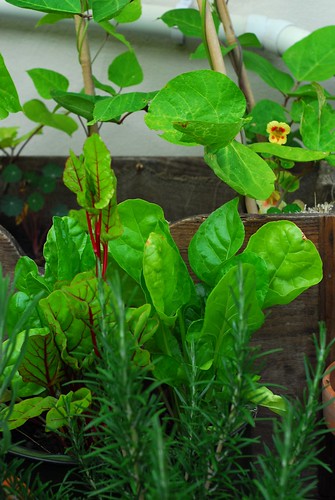
Mint: it grew, despite the best attempts of leaf-miners and caterpillars to eat it. Moreover, we kept forgetting we had mint leaves to use, leaving the mint bush to get rather overgrown and straggly; giving it a fierce trim rather more often would have left us with a healthier plant.
Feverfew: it grew very well, with attractive clusters of daisy-like flowers that have lasted well all summer. Now, we just have to work out what else it might be useful for.
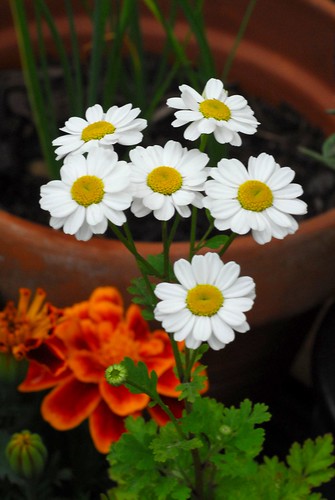
calendula, feverfew, french marigold, marigold, mint, pea, pentland early, potato, review, swiss chard
Posted in Photobloggery, The Old Garden In Bristol on Sunday, August 21st 2011 (5.15 PM).
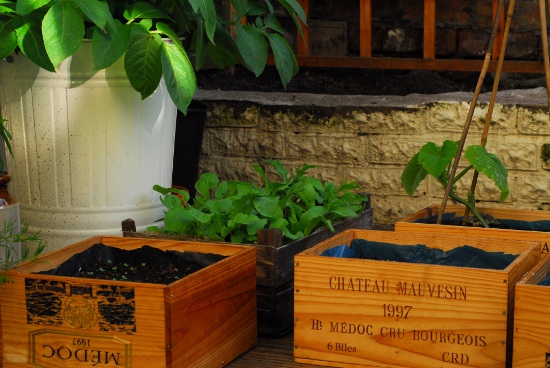
The back corner of the garden a couple of months back, when everything was still under the shadow of the potato leaves. Next year, the plan is for a rhubarb plant to take up the shade by the trellis.
containers, pattypan squash, plans, potato


